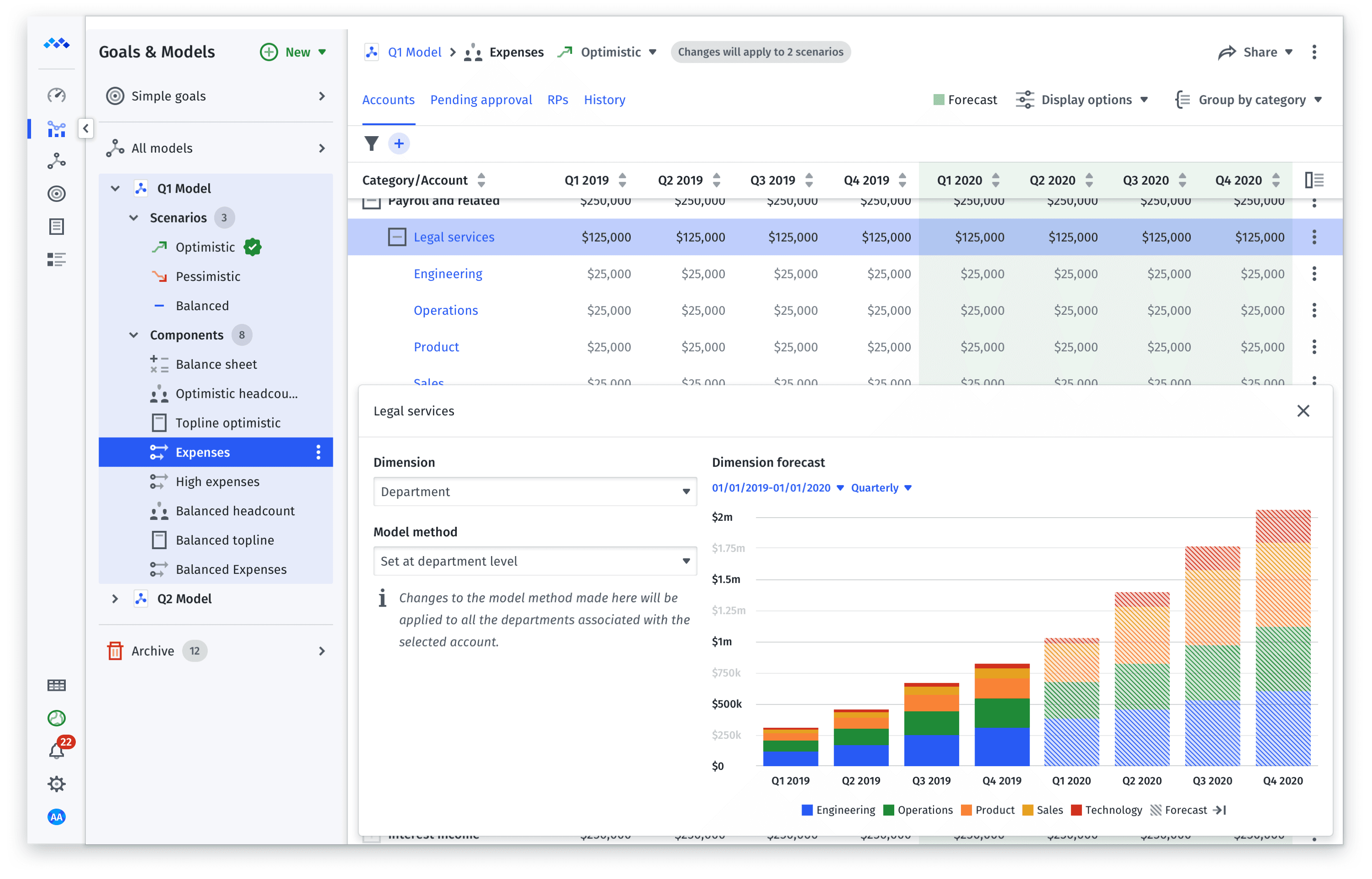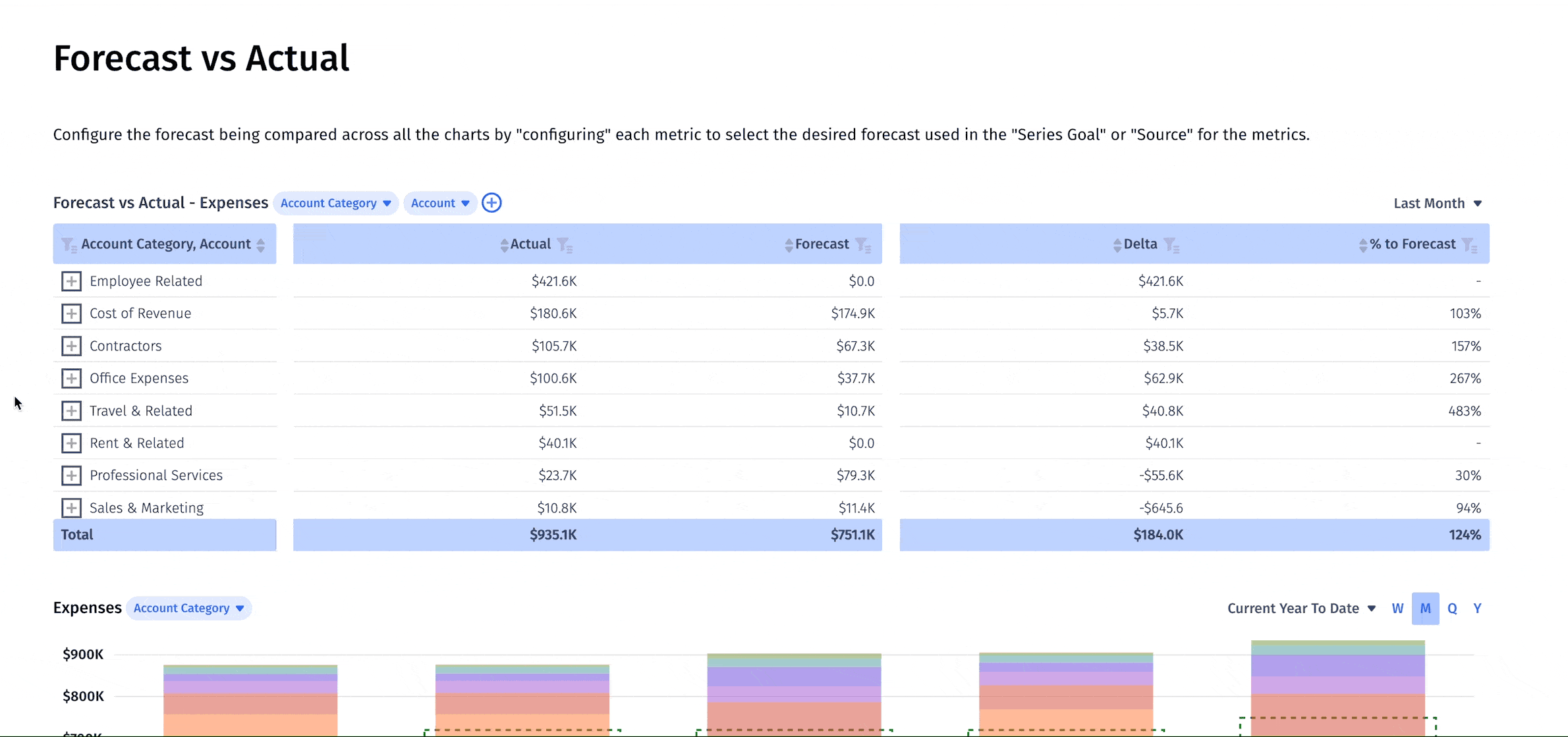Picture this: your company’s grown steadily over the past year. MRR is coming in, and your attrition rate remains low. But, over the last month or two, competitors in your channel rolled out new features that rapidly became standard. Suddenly, your finely tuned product-market fit no longer…fits.
A quick pivot is needed. The problem? The budget you made last year is focused almost solely on increasing revenue, not on building out new features to further differentiate your product. Now your CEO is calling for more R&D expense and less growth in sales and marketing, throwing a wrench into your beautifully crafted plan.
While hypothetical, this scenario isn’t at all unrealistic. Around 90% of SaaS startups fail. And it highlights an underlying problem: traditional financial plans lack flexibility.
If there’s one thing SaaS startups need, it’s flexibility because the SaaS industry is wrought with funding challenges, fluctuating churn rates, and stiff competition. Fortunately, thanks to FP&A software — not to mention the unpredictable nature of the past few years — a new, agile approach to FP&A has gone mainstream.
Table of Contents
What Is Agile Financial Planning?
Agile financial planning is a flexible budgeting method and forecasts that enables SaaS businesses to change direction if and when needed.
Agile planning helps teams identify and better understand the risks a company is (or may be) facing, so they can minimize exposure and maximize returns. It goes hand-in-hand with the concept of strategic finance and empowers teams to become more forward-thinking.
Why Agile Financial Planning Is Better For SaaS Businesses
When you read the phrase “traditional financial planning,” what’s the first thing that comes to mind? Probably the annual budget. You and your team painstakingly craft these budgets over planning season and, once they’re approved by the CEO and CFO, they can’t be changed — they’re the roadmap for the next year, and that’s that.
But it’s not hard to see how this inflexibility puts traditional budgets at an inherent disadvantage. Think of last planning season. How accurate were your Q3 or Q4 projections? Did you end up overspending? If your business was around during the pandemic, how did your budget adapt to that massive disruption or the subsequent high interest rates?
Accurately predicting business needs 12 months out isn’t easy, especially for SaaS companies where the internal and external landscape can change rapidly. Just a couple years ago, venture capital was seemingly falling from trees. Now, startups are struggling to maintain their cash runways. New product features can proliferate quickly, becoming standard in a matter of months.
The agile methodology in finance grants you the flexibility to realign your strategy quickly as priorities change, so you can still meet your overarching goals. It’s sort of like removing a Jenga block without the whole tower collapsing.
Traditional Financial Planning Is Quantitative, Agile Planning Is Qualitative
Traditional financial planning revolves around qualitative goals. For example, the company may set a plan to increase revenue by 15%. Finance sets aside the necessary funds, and the plan is put into motion.
The problem with this plan? It’s vague! It doesn’t have the connection between key business drivers and assumptions in view — a deep understanding of how those drivers and assumptions contribute to the desired outcomes. This system leaves plenty of room for waste.
The agile approach to financial management, on the other hand, is all about business drivers. So, rather than just setting a goal to increase revenue by a certain percentage and increasing the budget incrementally, you see how specific components of your business contribute to revenue
Driver-based planning is more flexible because it works backwards from relevant operational metrics like ARR per head or revenue per employee. With the right tool, you can see month-by-month how you’re performing in regard to those metrics, then make adjustments where needed. This helps optimize resource allocation, ensuring each dollar actually has the impact you want it to. With traditional budgets, departments often end up spending more than they need to just to meet the amount granted.
Agile, driver-based planning is more targeted, relying on a cause-and-effect understanding of your unique business. And, according to a study from Oracle, the result is measurable: agile finance leaders were 26% more likely to report positive revenue growth and 25% more likely to report increasing profitability.
Traditional Financial Planning Lacks Collaboration
Where traditional budgeting is a top-down approach set by management, agile budgeting is a bottom-up approach centered on cooperation between all business functions. The idea is to build company-wide goals, together, which can also increase morale. On the Role Forward podcast, Zack McCarty of Qwick spoke about his switch from traditional to agile, collaborative planning.
“Before,” he says, “we were just taking historicals and trying to build trends from there.” The transition was summed up by asking everyone, “Hey, what are we doing this year?” From there, Zack says he found more “buy-in for our planning because everybody had a stake in it.”
In the agile ideal, finance acts as a central hub — a data repository touching on all aspects of the business. With the right tools, building out financial models becomes an inter-departmental exercise, as each function understands the impact of their operations on the plan by referring to shared rolling forecasts. This then guides their decision-making, ensuring their actions remain in line with those driver-based goals that everyone agreed on.
To sum up:
- Traditional budgets rely on historical data, while agile budgets rely on current data along with drivers and connected assumptions
- Where traditional budgets and forecasts are rigid and don’t reflect the evolving market situation, an agile planning approach is flexible and does
- Traditional financial planning is based on incrementally increasing funds. An agile methodology in finance is based on collaboration, aligning the entire company around specific goals and related metrics.
What Are the Key Components of an Agile Financial Plan?
A successful agile financial plan has three components: driver-based forecasting, rolling forecasts, and real-time data.
Driver-Based Forecasts
Drivers are the “movers” of your business. They’re levers you directly control that lead to specific financial outcomes. For example, the company controls the number of sales reps under employ, and this number has a direct effect on revenue.
Where traditional revenue forecasting simply extrapolates historical data to estimate future growth, driver-based forecasting understands that revenue growth can be directly tied to drivers, in this case, sales reps.
Still, the way you forecast specific performance drivers is based on assumptions. For sales reps, you build out assumptions for things like quota attainment, attrition rate, and ramp rate, based on historical data. The difference with traditional forecasting is that your assumptions will be updated based on current data. If rolling forecasts show your assumptions are wrong, you can then adjust your budget plans to reflect the actual situation and still hit your targets.
Rolling Forecasts
What is a rolling forecast? Simply put, it’s a forecast that continuously updates based on actuals. While traditional forecasts expire once the period they cover has elapsed, a rolling forecast is constantly being “pushed forward.” This means that the rolling forecast will always have a set view of the future, say 6 months (if you set up a 6-month forecast in January, you’ll still have a 6-month outlook in February, March, April, and so on).
With the right tools, you can build rolling forecasts that focus on different areas of your business like headcount or revenue. You then tie these to your driver-based goals and adjust to your plans monthly based on the evolving situation.
Rolling forecasts also help provide a baseline for scenario planning. Scenario planning is crucial for agile financial planning — by building scenario plans with best and worst-case scenarios, you can devise contingency plans.

Real-Time Data
Rolling forecasts depend on real-time data. The best way to get access to that data is from your own systems: CRM, ERP, and HRIS. Software like Mosaic integrates with your existing tech stack and generates financial models and scenario plans based on your own real-time information.
The Mosaic Advantage
The advantages of agile financial planning are clear. The only potential drawback? It’s complicated. With so many moving pieces, from drivers and KPIs to rolling forecasts, you’re probably wondering, “Can I do this with spreadsheets?” While the answer is (technically) yes, you can’t leverage the full power of agile financial planning with spreadsheets.
That’s because it takes a lot of time to build rolling forecasts and update your models with actuals from your CRM or ERP if you rely on spreadsheets. This means you can’t react quickly — you might always be a few days behind.
Spreadsheets are also notoriously poor collaborative tools thanks to problems with version control. If everyone’s editing models with their own data, things can get confusing, fast.
To make your finance function truly agile, you need software that brings all data to one centralized location. A tool that everyone can use that makes it simple to build financial models and create scenario plans. A tool that saves you from time-consuming tasks like data cleansing, so you can actually act on what the information is telling you.

Built around clear, beautiful charts that provide real-time views of KPIs, Mosaic’s reports lay the foundation for flexible plans that help you achieve your financial goals in the face of an uncertain market. Customizable dashboards are easy to understand even for those outside of finance, making them ideal for sharing with team members, stakeholders, and potential financiers. With Mosaic, everyone can “speak the same language,” understanding how individual initiatives are affecting the plans without being inundated by finance jargon.
Agile Financial Planning Checklist
Go through this checklist to determine if you have an agile financial planning process in place:
- First, do you have strategic goals that you can tie to drivers? Drivers are factors your business controls that tie to specific outcomes. For example, revenue growth is tied to the number of sales reps. It’s important for goals to be tied to measurable drivers, as that allows you to track progress toward them throughout the year via rolling forecasts.
- Build rolling forecasts. Set up a process that generates rolling forecasts each month. Use them to learn if you are still on target toward achieving your strategic goals.
- Set up processes for transparency. Agile financial planning is a collaborative process. Everyone should understand the key drivers and metrics that need to be followed on the path to achieving specific goals.
- Lastly, leverage scenario planning. You can modify key drivers to see how much of an impact they have on your business. And, since your drivers still have assumptions tied to them, you can tweak your assumptions to see how much of an impact each would have if you’re off-base.
Embracing Agility
Agile financial planning makes sense for all businesses that want to grow quickly, and especially for SaaS companies — in a field where last year may not look anything like this year, it’s clear that static budgets and forecasts just can’t keep pace.
To get the most out of an agile methodology in finance, leverage a tool like Mosaic that does the busy work for you and helps you get from data to decision faster. With over 150 SaaS metrics, along with unlimited custom metrics, Mosaic helps you see whether you’re hitting the mark by generating financial models and “what-if” scenario plans. The goal is to democratize information so financial decisions go beyond financial planners alone.
If you need to pivot or react to a market change, you need to make a decision quickly – but that decision needs to be data-backed. Make better decisions by leveraging agile modeling and cash flow forecasting software that keeps up with the “speed of business,” granting you the flexibility and adaptability you need to remain competitive.
Agile Financial Planning FAQs
Why is agile financial planning particularly important for SaaS businesses?
SaaS businesses are subject to a unique environment that’s constantly changing. Competition, shifts in product-market fit, and increased or decreased access to funding can all make the SaaS landscape unpredictable. And the ability to react quickly when circumstances change can make or break a SaaS startup.
How can Mosaic support my business in agile financial planning?
Own the of your business.

